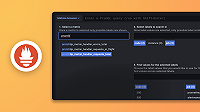Important: This documentation is about an older version. It's relevant only to the release noted, many of the features and functions have been updated or replaced. Please view the current version.
Grafana Mimir deployment modes
You can deploy Grafana Mimir in one of two modes:
- Monolithic mode
- Microservices mode
The deployment mode is determined by the -target parameter, which you can set via CLI flag or YAML configuration.
Monolithic mode
The monolithic mode runs all required components in a single process and is the default mode of operation, which you can set by specifying -target=all. Monolithic mode is the simplest way to deploy Grafana Mimir and is useful if you want to get started quickly or want to work with Grafana Mimir in a development environment. To see the list of components that run when -target is set to all, run Grafana Mimir with the -modules flag:
./mimir -modulesMonolithic mode can be horizontally scaled out by deploying multiple Grafana Mimir binaries with -target=all. This approach provides high-availability and increased scale without the configuration complexity of the full microservices deployment.
Microservices mode
In microservices mode, components are deployed in distinct processes. Scaling is per component, which allows for greater flexibility in scaling and more granular failure domains. Microservices mode is the preferred method for a production deployment, but it is also the most complex.
In microservices mode, each Grafana Mimir process is invoked with its -target parameter set to a specific Grafana Mimir component (for example, -target=ingester or -target=distributor). To get a working Grafana Mimir instance, you must deploy every required component. For more information about each of the Grafana Mimir components, refer to Architecture.
If you are interested in deploying Grafana Mimir in microservices mode, we recommend that you use Kubernetes and the mimir-distributed Helm chart.
Read-Write mode
Warning: Read-Write deployment mode is experimental.
The read-write mode provides an alternative to monolithic and microservices modes.
In read-write mode, components are grouped into three services to ease the operational overhead whilst still allowing scale to be tuned separately on the read and write paths. The services group the components as follows:
- read
- query-frontend
- querier
- backend
- store-gateway
- compactor
- ruler
- alertmanager
- query-scheduler
- overrides-exporter
- write
- distributor
- ingester
Similar to the other modes, each Grafana Mimir process is invoked with its -target parameter set to the specific service: -target=read, -target=write, or -target=backend.
Read-write mode is only available in Jsonnet.


